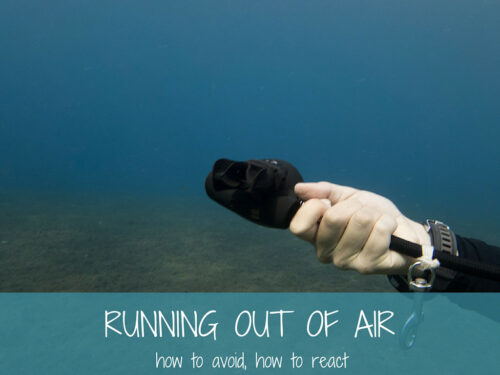The Fear of Running Out of Air: Deconstructing Scuba’s Multi-Layered Safety System
Of all the diving fears discussed in our Overcoming Fears series, the fear of running out of air is perhaps the most logical and primal. Air is life. The thought of being without it in an environment where we cannot breathe naturally is terrifying.
And precisely because it is such a real and serious risk, the entire foundation of modern recreational scuba—from equipment design to training protocols to diving culture—is built to create a multi-layered safety system that makes a true “out-of-air” situation virtually impossible for a properly trained diver. This Amadive article will break down each layer of defense, turning your fear into trust in the system.

Layer 1: Reliable Monitoring Equipment
Your equipment doesn’t just deliver air; it’s a constant information system.
- The Submersible Pressure Gauge (SPG): This is not an optional accessory; it is a core part of your life-support system. Think of it as a car’s fuel gauge, but far more reliable. It is designed for simplicity and durability.
- Amadive’s Experience: In the Open Water course, we will drill a habit into you until it becomes instinct: check your SPG every few minutes. It’s not just an action; it’s part of the rhythm of your dive. This habit alone eliminates 90% of the risk of being surprised by a low air supply.
Layer 2: Proactive Planning and Gas Management
A safe diver never begins a dive without a plan.
- The Golden Rule: “Plan Your Dive, Dive Your Plan”: Before entering the water, you and your guide will agree on a plan. A critical part of that plan is gas management. For example: “We will begin our return when the first person in the group reaches 100 bar.”
- The Safety Reserve: An unwritten rule in the industry is to always end your dive and be back on the boat with a safe reserve of air in your tank, typically 50 bar. This air is not for use; it is your safety buffer for unforeseen circumstances, like a longer-than-expected safety stop.
Layer 3: The Comprehensive Redundancy System
This is the most critical layer, built on the principle of “never relying on a single thing.”
- The Buddy System: Your dive buddy is more than just company. They are a mobile, redundant air supply. The entire buddy system is designed for mutual support in case of an issue.
- The Alternate Air Source / Octopus: Every modern regulator is equipped with a second regulator, usually bright yellow for high visibility.
- The Skill Practice: In the pool, you will practice both giving and receiving air from an alternate until it is second nature. You will learn how to approach your buddy, signal “out of air,” take their alternate, and breathe and ascend together safely. This skill turns a potential emergency into a practiced procedure.
Layer 4: Personal Skills
- Breath and Buoyancy Control: A calm, relaxed diver with perfect buoyancy will consume significantly less air than one who is anxious and struggling. The course teaches you how to move efficiently to maximize your time underwater.
- The Pre-Dive Safety Check: The “BWRAF” procedure you perform with your buddy before every dive includes the crucial step “A” for Air. You will check that each other’s tank valve is fully open and take a test breath from both regulators to ensure they function properly.
Frequently Asked Questions (FAQ)
- What if my gear fails and leaks air quickly?
- This is extremely rare with well-maintained equipment. However, if it were to happen, that is precisely why the buddy system and the alternate air source exist. You would immediately switch to your buddy’s air supply and end the dive.
- Can I get overwhelmed and breathe so fast that I run out of air?
- Anxious breathing will consume your air faster, but not instantly. You will notice the needle on your SPG moving more quickly. That is your signal to stop, calm down, slow your breathing, and, if necessary, signal to your buddy and end the dive earlier than planned.
Conclusion: Trust in a Robust Safety System
The fear of running out of air is a valid one, but it is addressed by one of the best redundant safety systems in any adventure sport. Running out of air is not a random accident; it’s the result of ignoring multiple layers of safety and training. When you understand and trust these layers—your gear, your plan, your buddy, and your own skills—the fear is replaced by confidence and a focus on enjoying the underwater world.
Important Disclaimer: Your safety depends on strict adherence to your training. Always maintain your equipment, perform pre-dive checks, and dive your plan.
